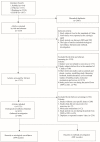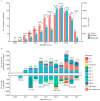Prevalence and Etiological Characteristics of Norovirus Infection in China: A Systematic Review and Meta-Analysis
- PMID: 37376635
- PMCID: PMC10302178
- DOI: 10.3390/v15061336
Prevalence and Etiological Characteristics of Norovirus Infection in China: A Systematic Review and Meta-Analysis
Abstract
Norovirus is a common cause of sporadic cases and outbreaks of gastroenteritis worldwide, although its prevalence and the dominant genotypes responsible for gastroenteritis outbreaks remain obscure. A systematic review was conducted on norovirus infection in China between January 2009 and March 2021. A meta-analysis and beta-binomial regression model were used to explore the epidemiological and clinical characteristics of norovirus infection and the potential factors contributing to the attack rate of the norovirus outbreaks, respectively. A total of 1132 articles with 155,865 confirmed cases were included, with a pooled positive test rate of 11.54% among 991,786 patients with acute diarrhea and a pooled attack rate of 6.73% in 500 norovirus outbreaks. GII.4 was the predominant genotype in both the etiological surveillance and outbreaks, followed by GII.3 in the etiological surveillance, and GII.17 in the outbreaks, with the proportion of recombinant genotypes increasing in recent years. A higher attack rate in the norovirus outbreaks was associated with age group (older adults), settings (nurseries, primary schools, etc.) and region (North China). The nation-wide pooled positive rate in the etiological surveillance of norovirus is lower than elsewhere in the global population, while the dominant genotypes are similar in both the etiological surveillance and the outbreak investigations. This study contributes to the understanding of norovirus infection with different genotypes in China. The prevention and control of norovirus outbreaks during the cold season should be intensified, with special attention paid to and enhanced surveillance performed in nurseries, schools and nursing homes from November to March.
Keywords: China; etiological characteristics; meta-analysis; norovirus.
Conflict of interest statement
The authors declare no conflict of interest.
Figures




References
-
- Pires S.M., Fischer-Walker C.L., Lanata C.F., Devleesschauwer B., Hall A.J., Kirk M.D., Duarte A.S., Black R.E., Angulo F.J. Aetiology-specific estimates of the gobal and regional incidence and mortality of diarrhoeal diseases commonly transmitted through food. PLoS ONE. 2015;10:e0142927. doi: 10.1371/journal.pone.0142927. - DOI - PMC - PubMed
Publication types
MeSH terms
LinkOut - more resources
Full Text Sources
Medical

